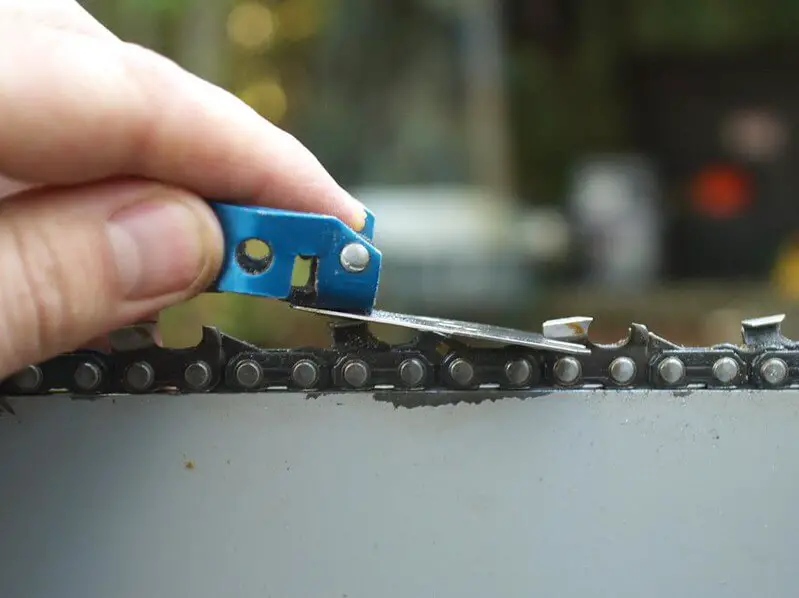The most significant evolutionary leap in the history of cutting tools has to be the shift from ax to a chainsaw. Thanks to this impressive invention, felling trees became amazingly effortless and less time-consuming. Unfortunately, not even the most high-tech chainsaw is immune to blade dulling.
However, the good news is that it is possible to sharpen your chainsaw to a like-mint condition in a matter of minutes. All you need are the right tools and the know-how. This article will provide a detailed breakdown to ensure you always keep your tool in tip-top condition with the best way to sharpen a chainsaw.
3 Ways of sharpening a chainsaw
File Sharpener
To file your chainsaw by hand, you need a round file sharpener that matches the diameter of the saw’s cutting edges. While the size of these semi-circular edges varies depending on the type of chainsaw, they typically range from 7/32 inches to 5/32 inches.

You will also need a sharpening guide on which to mount the file. The guide will help you maintain the right filing angle and control your filing depth. Start by positioning the file against the cutting edges and setting the sharpening guide on the chainsaw.
Ensure the angled lines at the top of the sharpening guide are aligned parallel to the chainsaw’s steel bar. Maintain this angle as you stroke the file forward and backward repeatedly for every tooth.
Portable Power Sharpeners
If you thought hand filing was effective, wait until you try power sharpening! Portable power tools, most notably the rotary tool and the electric rotary grinder, make light work of saw chain sharpening. The rotary tool is portable sharpening equipment that can run on a meager 12 volts.
It is ideal for those fond of working in the field as you can easily run it off your car battery. You will need to purchase an accessory kit consisting of an alignment guide and a grinding stone to use this power tool.
Bench-Top Sharpener
As the name suggests, a bench-top sharpener should be clamped on a workbench before use. It features a grinding wheel with a 41/2 inch diameter and a wheel capable of tilting 35o to the right or left.

To use it, remove the chain from the saw, position it in the vice, ensure the grinder is at the matching angle, and squeeze the trigger while pulling down the upper handle.
Make sure the spinning wheel comes into contact with the cutting tooth. After you release the clamp, repeat this process for all grinding angles and teeth. Surprisingly, each clamp squeeze will take you no more than three seconds.
The best method of sharpening a chainsaw
Bench-top is the fastest and most convenient means of sharpening your chainsaw, making it the best option out of the three. Repeatedly squeezing and releasing the clamp will take 5 minutes as you go through all the teeth and their respective grinding angles.
Moreover, this is a near-perfect option as it is almost impossible to damage your chain saw while sharpening.
The grinder and sharpener’s vice ensure you maintain ideal angles, thus preventing you from grinding away excess material. Its only shortcoming is that sharpening can only take place on your workbench.
Nonetheless, what the bench-top sharpener lacks in portability, it makes up for in convenience, accuracy, and consistent sharpening results. Read our detailed post on how to use the bench-top tool to sharpen your chainsaw.
Why does my chainsaw chain dull quickly?
You might have noticed that your chainsaw gets dull rather quickly. There are a couple of things that can cause this irritating tendency. You might apply a lot of pressure when filing, or you do not use the right file for your chain’s edges. Sometimes, your chain might also dull quickly due to overexposure to soil or dirt when felling trees.
The good news is that you can solve this issue with a few adjustments. Following the user’s manual when sharpening your chain is a great place to start. Follow every prompt to the letter to ensure you use the right sized material and apply an accurate amount of force.
Also, remove tree barks before using your chainsaw. Simply chop off a section of the bark using an ax and use your chainsaw from that spot.
Summary
In conclusion, not even the most sophisticated chainsaw is immune to blade dulling. You must observe appropriate sharpening techniques and remove the bark of trees before cutting to slow down the dulling process.
Nonetheless, once dull, you can use a file, portable power tools, or the bench-top sharpener to bring your saw back to like-new condition. There is no overlooking the significance of keeping your chainsaw sharp.
Not only will this enhance your saw’s performance, but it will also make it last longer. Sharpening your chainsaw is the epitome of proper maintenance regimens; it gets you consistent, accurate results and the best value for your money!

